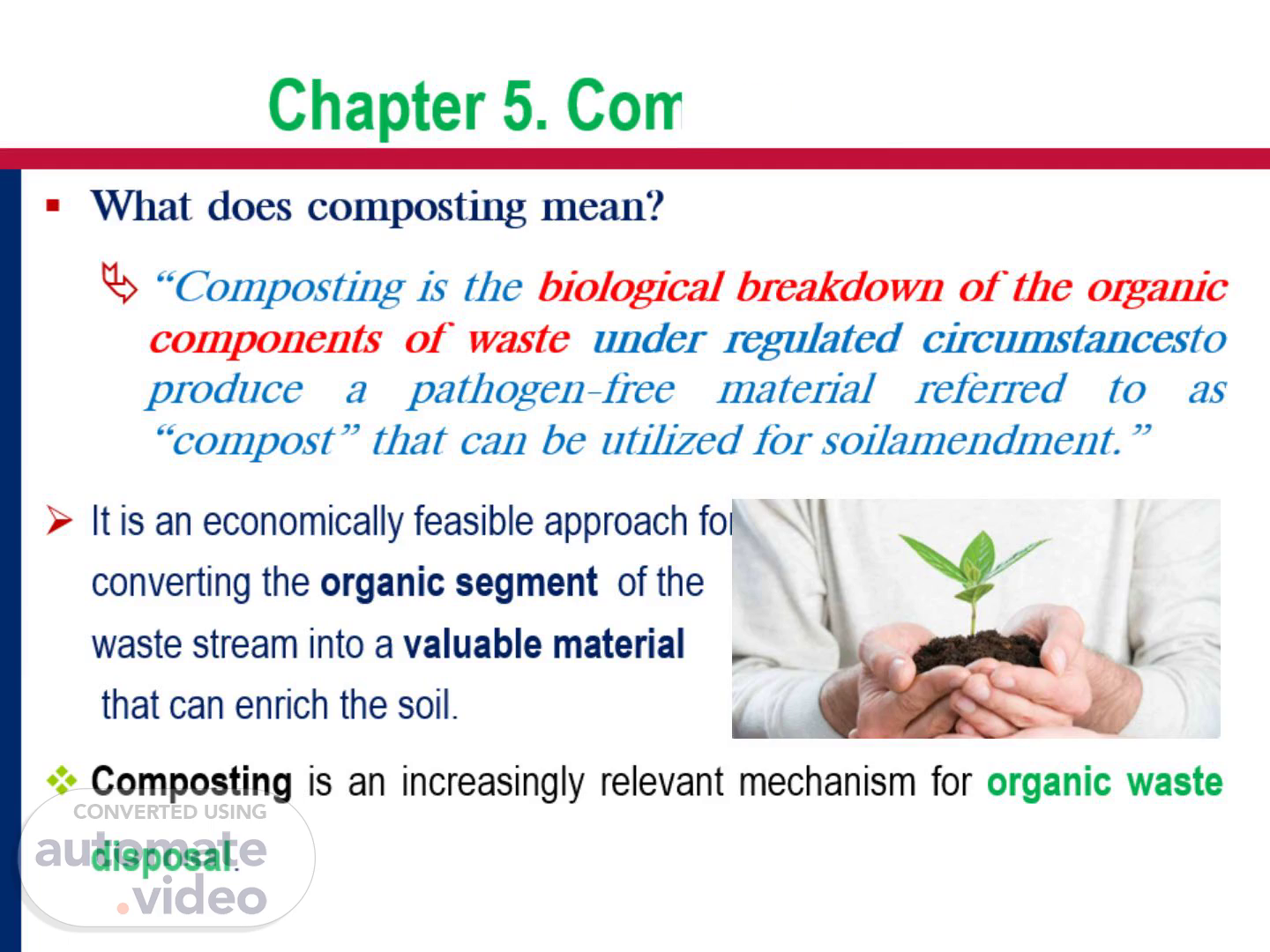Scene 1 (0s)
Chapter 5. Composting. What does composting mean? “Composting is the biological breakdown of the organic components of waste under regulated circumstancesto produce a pathogen-free material referred to as “compost” that can be utilized for soilamendment.” It is an economically feasible approach for converting the organic segment of the waste stream into a valuable material that can enrich the soil. Composting is an increasingly relevant mechanism for organic waste disposal..
Scene 2 (20s)
Composting …. Performed either by households or in large centralized units What items can be composted?.
Scene 3 (45s)
Types of composting. Composting systems can be categorized based on three main criteria: Oxygen usage (aerobic & anaerobic) Temperature (Mesophilic 15-45OC & Thermophilic 45-65OC) Technological approach (Static piles, windrow composting, passively aerated windrows, forced aeration,enclosed or in-container composting, vermicomposting)..
Scene 4 (1m 0s)
Technological method. Windrow composting: Windrow composting is the most affordable and straightforward method for municipal systems, in which organicwaste is placed in a large triangular piles (referred to as a windrow). These pyramid-shaped mounds of waste are generated to facilitate the diffusion of oxygen and the retention of heatto enhance microbial activity..
Scene 5 (1m 25s)
Types of composting …. Aerated stationary moundcomposting: Mechanical Aeration of waste mounds is achieved by positioning them through a system of pipes linked to a blower..
Scene 6 (1m 43s)
Types of composting …. In-container composting: This is a regulated procedure of compostingwhere aeration, humidity, and temperature needs for composting is preservedin a chamber or vessel. The advantages of this system compared to others are that it allows for regulation of the environmental factors for quick composting since it takes place within an enclosed structure, and the issues of malodor and leachate generation are minimal..
Scene 7 (2m 5s)
Types of composting …. Vermicomposting: or Vermiculture utilizes earthworms to generate a premium quality soilconditioner..
Scene 8 (2m 28s)
Composting Process. Decomposition of organic wasteis a natural phenomenon and starts nearly immediately after the waste is produced. Under environmental circumstances, earthworms, nematodes, and soil-dwelling insects like mites, sowbugs, springtails, ants, and beetlescarry out a significant portion of the primary mechanical fragmentation of organic substances into smallerparticles, thus enhancing their susceptibility to microbial breakdown. Under regulated circumstances, compost makers/composting facilitators break down large particles through grinding or chopping..
Scene 9 (2m 50s)
Composting Procedure. Once ideal physical conditions are set, microorganisms populate the organic matter and commence the composting procedure. Numerous microbes that play a role in decay are found within the waste materials. Soil microbes such as; Bacteria, Fungi, Actinobacteria and Protozoa iIntroduced when the waste is blended with soil or inoculated with completed compost Thus, they colonize the natural substances and begin the compostingprocess..
Scene 10 (3m 9s)
Composting Procedure …. 10. During composting, These microorganisms are utilized ‘carbon cpds found in organic substances serving as an energy source and converted intoCO2 and heat released into the env’t..
Scene 11 (3m 28s)
Stages of composting. 11. The composting procedure consists of three stages.These are: Mesophilic phase Thermophilic Phase Maturation stage.
Scene 12 (3m 41s)
Phases of composting process …. 12. [image] Composting has 3 phases: Mesophili Thermophilic Cooling/maturation (pseudomonads) (Bac illus, then (Bacillus, pseudomonads, Thennus) others).
Scene 13 (4m 5s)
Phases of composting process …. 13. [image] Composting has 3 phases: 60 so 40 20 Mesophil' Thermophilic (pseudomonads) (Bacillus, then Thermus) Coolinglmaturation (Bacillus, pseudomonads, others).
Scene 14 (4m 27s)
Phases of composting process …. In the engaged “thermophilic” stage, temperatures are sufficiently elevated to eliminate pathogens and weed seeds and to decompose phytotoxic substances(organic substances harmful to plants)). Common microorganisms eliminated during this stageare; Escherichia coli, Staphylococcus aureus, Bacillus subtilis, and Clostridium botulinum. During During this stage, oxygen has to be restored via passive or active aeration, or by turning the compost heap..
Scene 15 (4m 48s)
Phases of composting process …. 15. [image] Composting has 3 phases: M&phil Thermophilic Cooling,'maturation (pseudomonads) (Bacillus , then (Bacillus, pseudomonads, Thermus) others).
Scene 16 (5m 16s)
When is the compost ready?. There is no set timeframe to create completedcompost. Duration depends on category of raw materials, method used for composting and management. It can take as little as three months and for a duration of up to two years. Compost is regarded as completewhen; the raw feedstocks are no longer in the process of active decompositionand are biologically and chemically consistent. When the temperaturein the heart of the stackreturns to close to ambient levels and oxygen concentrations in the center of the heap stay larger than 10-15% over a number of days, compost is regarded as stable or complete..
Scene 17 (5m 43s)
Products obtained:. The final compost is identified by its earthy odor and dimbrown color..
Scene 18 (5m 54s)
Advantages of incorporating compost into soils. Compost is especially beneficial as natural fertilizer that provides essential plant nutrients alongside micronutrients that support plant growth. Compost is a source of organic matter and can be used both as a fertilizer and a soil enhancer as it provides traits such as: good water retention, storage abilities, porosity and structure..
Scene 19 (6m 11s)
Elements influencing the composting procedure and its quality.
Scene 20 (6m 27s)
Elements influencing the composting procedure and its quality.
